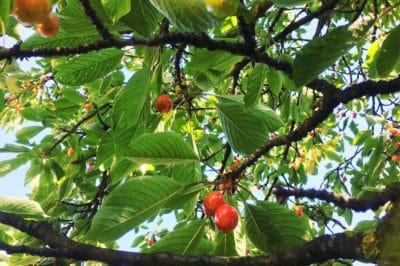Four Common Species of Cherry Trees
Cherry trees are stone fruit, belonging to the same plant family as plums, peaches, nectarines, and almonds. There are dozens of species of cherry tree but four are most common.
- Prunus avium is the species containing sweet cherry varieties widely cultivated for fresh fruit.
- Prunus cerasus are trees in the sour cherry group with a sour taste but good for cooking.
- Prunus serrulata are flowering, ornamental cherry trees which often do not have any fruit or only small fruit enjoyed by birds.
- Prunus serotina, or black cherry, is a wild cherry tree native to North and South America with wood used in furniture making.
What to Look for in Cherry Tree Identification
There are several aspects of the tree you can look for to help in identification.
Flowers
The blossoms of cherry trees are white or pink in color. While these flowers are showy and beautiful, they usually have little or no scent, unlike plum blossoms with are fragrant.
The flowers on cherry trees grow in clusters with stamens emerging from the flowers, while the flowers of plum, peach, and almond trees do not form clusters. Also, if you look closely at the petal of a cherry blossom, you will see a small dimple in the edge of each one.
Leaves
The leaves on cherry trees are between 2.5 and 5 inches (6.3 and 12.7cm) in length. Their shape varies from oval to lance-shaped, but there is a pointy tip at the end of the leaf, and the edges of leaves are finely serrated.
Leaves on cherry trees are bright green, and they grow on the branch staggered from each other. Leaves higher up in the tree may be slightly lighter in color, and all leaves turn reddish-yellow and drop from the tree in the fall.
Bark
The bark of cherry trees varies in color, but it is usually arranged in horizontal, strip-like layers. In some types of cherry tree, the bark peels from the trunk in spots and is a darker color underneath.
Fruit
Not all cherry trees produce fruit, but in those that do, the fruit grows in clusters or in groups of two. Fruit starts out pale green in color and then develops a red, yellow, or black color at maturity, depending on the variety.
Cherries are small fruits, averaging about ¾ inch (1.9 cm) in diameter on edible varieties.
